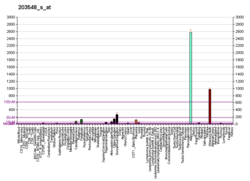| Lipoprotein lipase | |||||||||
|---|---|---|---|---|---|---|---|---|---|
| Identifiers | |||||||||
| EC no. | 3.1.1.34 | ||||||||
| CAS no. | 9004-02-8 | ||||||||
| Databases | |||||||||
| IntEnz | IntEnz view | ||||||||
| BRENDA | BRENDA entry | ||||||||
| ExPASy | NiceZyme view | ||||||||
| KEGG | KEGG entry | ||||||||
| MetaCyc | metabolic pathway | ||||||||
| PRIAM | profile | ||||||||
| PDB structures | RCSB PDB PDBe PDBsum | ||||||||
| Gene Ontology | AmiGO / QuickGO | ||||||||
| |||||||||
Lipoprotein lipase (LPL) (EC 3.1.1.34, systematic name triacylglycerol acylhydrolase (lipoprotein-dependent)) is a member of the lipase gene family, which includes pancreatic lipase, hepatic lipase, and endothelial lipase. It is a water-soluble enzyme that hydrolyzes triglycerides in lipoproteins, such as those found in chylomicrons and very low-density lipoproteins (VLDL), into two free fatty acids and one monoacylglycerol molecule:
- triacylglycerol + H2O = diacylglycerol + a carboxylate
It is also involved in promoting the cellular uptake of chylomicron remnants, cholesterol-rich lipoproteins, and free fatty acids.[5][6][7] LPL requires ApoC-II as a cofactor.[8][9]
LPL is attached to the luminal surface of endothelial cells in capillaries by the protein glycosylphosphatidylinositol HDL-binding protein 1 (GPIHBP1) and by heparan sulfated peptidoglycans.[10] It is most widely distributed in adipose, heart, and skeletal muscle tissue, as well as in lactating mammary glands.[11][12][13]
- ^ a b c GRCh38: Ensembl release 89: ENSG00000175445 – Ensembl, May 2017
- ^ a b c GRCm38: Ensembl release 89: ENSMUSG00000015568 – Ensembl, May 2017
- ^ "Human PubMed Reference:". National Center for Biotechnology Information, U.S. National Library of Medicine.
- ^ "Mouse PubMed Reference:". National Center for Biotechnology Information, U.S. National Library of Medicine.
- ^ Cite error: The named reference
Mead-2002was invoked but never defined (see the help page). - ^ Rinninger F, Kaiser T, Mann WA, Meyer N, Greten H, Beisiegel U (July 1998). "Lipoprotein lipase mediates an increase in the selective uptake of high density lipoprotein-associated cholesteryl esters by hepatic cells in culture". J. Lipid Res. 39 (7): 1335–48. doi:10.1016/S0022-2275(20)32514-1. PMID 9684736.
- ^ Ma Y, Henderson HE, Liu MS, Zhang H, Forsythe IJ, Clarke-Lewis I, Hayden MR, Brunzell JD (November 1994). "Mutagenesis in four candidate heparin binding regions (residues 279-282, 291-304, 390-393, and 439-448) and identification of residues affecting heparin binding of human lipoprotein lipase". J. Lipid Res. 35 (11): 2049–59. doi:10.1016/S0022-2275(20)39951-X. PMID 7868983.
- ^ Kim SY, Park SM, Lee ST (January 2006). "Apolipoprotein C-II is a novel substrate for matrix metalloproteinases". Biochem. Biophys. Res. Commun. 339 (1): 47–54. doi:10.1016/j.bbrc.2005.10.182. PMID 16314153.
- ^ Kinnunen PK, Jackson RL, Smith LC, Gotto AM, Sparrow JT (November 1977). "Activation of lipoprotein lipase by native and synthetic fragments of human plasma apolipoprotein C-II". Proc. Natl. Acad. Sci. U.S.A. 74 (11): 4848–51. Bibcode:1977PNAS...74.4848K. doi:10.1073/pnas.74.11.4848. PMC 432053. PMID 270715.
- ^ Meneghetti MC, Hughes AJ, Rudd TR, Nader HB, Powell AK, Yates EA, Lima MA (September 2015). "Heparan sulfate and heparin interactions with proteins". Journal of the Royal Society, Interface. 12 (110): 0589. doi:10.1098/rsif.2015.0589. PMC 4614469. PMID 26289657.
- ^ Wang CS, Hartsuck J, McConathy WJ (January 1992). "Structure and functional properties of lipoprotein lipase" (PDF). Biochimica et Biophysica Acta. 1123 (1): 1–17. doi:10.1016/0005-2728(92)90119-M. PMID 1730040.
- ^ Wong H, Schotz MC (July 2002). "The lipase gene family". Journal of Lipid Research. 43 (7): 993–9. doi:10.1194/jlr.R200007-JLR200. PMID 12091482.
- ^ Braun JE, Severson DL (October 1992). "Regulation of the synthesis, processing and translocation of lipoprotein lipase". The Biochemical Journal. 287 ( Pt 2) (2): 337–47. doi:10.1042/bj2870337. PMC 1133170. PMID 1445192.





